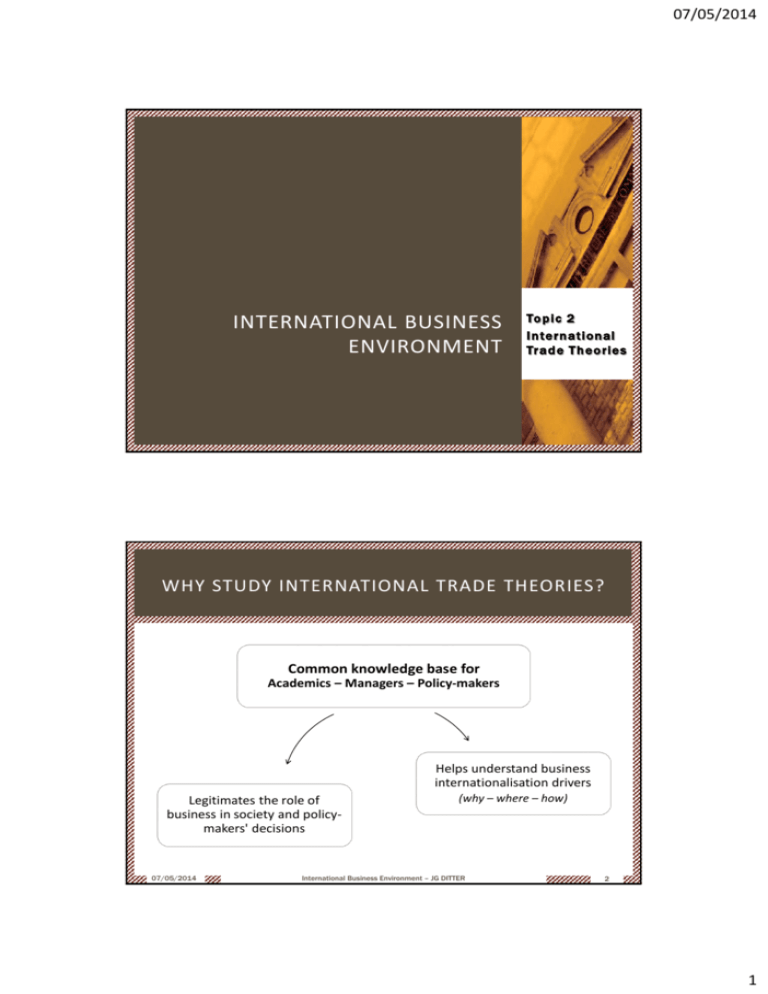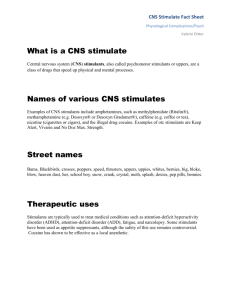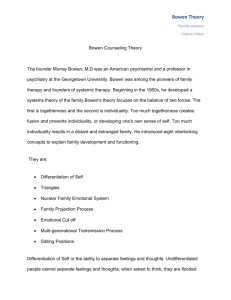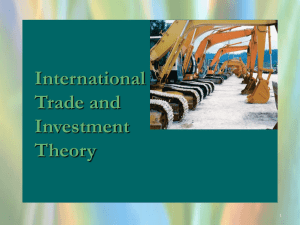International business environment
advertisement

07/05/2014 INTERNATIONAL BUSINESS ENVIRONMENT Topic 2 International Trade Theories WHY STUDY INTERNATIONAL TRADE THEORIES? Common knowledge base for Academics – Managers – Policy-makers Helps understand business internationalisation drivers Legitimates the role of business in society and policymakers' decisions 07/05/2014 (why – where – how) International Business Environment – JG DITTER 2 1 07/05/2014 KEY INTERNATIONAL TRADE THEORIES (Neo-) Mercantilism Modern (firm-based) theories Vernon's product life-cycle New trade theory Country similarity, Country size, gravity model 07/05/2014 Traditional (countrybased) theories Absolute advantage Comparative advantage Factor proportion Eclectic theories National competitiveness diamond Internalisation theory Eclectic (OLI) paradigm International Business Environment – JG DITTER 3 MERCANTILISM Original XVII th century mercantilists, such as John Law, a Scots financier, believed that a country's economic prosperity and political power came from its stocks of precious metals. To maximise these stocks they argued against free trade, favouring protectionist policies designed to minimise imports and maximise exports, creating a trade surplus that could be used to acquire more precious metal http: / / w w w. e c o no m i s t. c o m/ re s e a rc h/ Ec o no m ic s /a l p ha be t ic . c f m? le tte r = M # me rc a nt i lis m 07/05/2014 International Business Environment – JG DITTER 4 2 07/05/2014 VARIOUS FORMS OF MERCANTILISM Commercialism (export promotion) Colbertism (import substitution) Bullionism (gold accumulation) 07/05/2014 International Business Environment – JG DITTER 5 MERCANTILISM TODAY Neo-mercantilism is a term used to describe a policy regime which encourages exports, discourages imports, controls capital movement and centralises currency decisions in the hands of a central government The objectives of neo-mercantilist policies are to: (1) Increase the level of foreign currency deposits and bonds held by central banks and monetary authorities (foreign exchange reserves) (2) Support growth in GDP and employment at home. Adapted from: http://www.project-syndicate.org/print/mercantilism-reconsidered 07/05/2014 International Business Environment – JG DITTER 6 3 07/05/2014 ECONOMICS OF NEO-MERCANTILISM National income accounts Balance of payments Y = C + I + G + EX – IM Current account + (financial account) = 0 A country running a trade surplus earns more income from exports than it spends on imports A country running a trade surplus is a creditor to the world and can increase its reserve assets Net foreign wealth is increasing 07/05/2014 International Business Environment – JG DITTER 7 AN ASIAN MODEL? The growth champions of the past few decades – Japan in the 1950s and 1960s, South Korea from the 1960s to the 1980s, and China since the early 1980s – have all had activist governments collaborating closely with large business. All aggressively promoted investment and exports while discouraging (or remaining agnostic about) imports. China's pursuit of a high-saving, large-trade-surplus economy in recent years embodies mercantilist teachings. http://www.europeanceo.com/news/commentaries//article672.html 07/05/2014 International Business Environment – JG DITTER 8 4 07/05/2014 THE CHINESE CASE 2011, Md USD PPP Y C I G X M CHN 11300 3902 5490 1484 3230 2938 USA 14991 10729 2236 2594 2094 2662 07/05/2014 X-M C/Y I/Y G/Y X+M/2Y CHN 292 0,35 0,49 0,13 0,27 USA -568 0,72 0,15 0,17 0,16 International Business Environment – JG DITTER 9 GOVERNMENT-BUSINESS ISSUES Business organisations must take into account governments' involvement in supporting exports and limiting imports Macroenomic policies Microeconomic policies Fiscal – Monetary policies Foreign exchange policy Industrial policy – Education and infrastructure – Public procurement – Market regulation Trade policy Export promotion – Import restriction 07/05/2014 International Business Environment – JG DITTER 10 5 07/05/2014 FOOD FOR THOUGHT … "Hymns to export are only stupidity and lies. They assume not to be aware of the futility of any distinction between domestic and international trade." Jacques Rueff, L'Ordre Social, 1981 07/05/2014 International Business Environment – JG DITTER 11 MERCANTILISM DEFICIENCIES Promotes exports and savings at the expense of domestic demand / living standards Renders the domestic economy dependent on trade partners' business cycle "Beggar-thy-neighbour" strategy … Carried-out at the expense of trade partners, likely to turn into trade war Generating imbalances between creditors and debtors, likely to result in economic crisis Leading to global depression if applied by all players 07/05/2014 International Business Environment – JG DITTER 12 6 07/05/2014 MERCANTILISM DEFICIENCIES (RE MINDE R) Y=C+I+G+X–M → X – M = Y – (C + G + I) → X – M = (Y – (C + G)) – I X–M=S–I X>M ↔ S>I C: Household consumption I: Business investment S: Savings T: taxes 07/05/2014 G: Government spending EX: Exports IM: Imports International Business Environment – JG DITTER 13 ASSIGNMENT – GERMANY Germany is sometimes called a mercantilist country (see below). Please explain and discuss. The text argues that Germany's trade surplus is a problem for the Eurozone ... and Germany itself. Please explain and discuss. "Euro membership has encouraged Germany into a costly mercantilist strategy at the expense of its people and the productivity of the economy". Martin Wolf, Financial Times http://www.ft.com/intl/cms/s/0/1e2f2cd0-064e-11e2-bd29-00144feabdc0.html#axzz2znVp8kP7 07/05/2014 International Business Environment – JG DITTER 14 7 07/05/2014 FOOD FOR THOUGHT … "An international economics course should drive home to students the point that international trade is not about competition, it is about mutually beneficial exchange. Even more fundamentally, we should be able to teach students that imports, not exports, are the purpose of trade. That is, what a country gains from trade is the ability to import what it wants. Exports are not an objective in and of themselves: the need to export is a burden that the country must bear because its import suppliers are crass enough to demand payment". Paul KRUGMAN, Pop Internationalism 07/05/2014 International Business Environment – JG DITTER 16 ABSOLUTE / COMPARATIVE ADVANTAGE Absolute advantage refers to the ability of a person or a country to produce a particular good at a lower absolute cost than another. 07/05/2014 Comparative advantage refers to the ability of a country to produce a particular good at a lower marginal or opportunity cost than another country. The net benefits of such an outcome are called gains from trade. International Business Environment – JG DITTER 17 8 07/05/2014 ABSOLUTE / COMPARATIVE ADVANTAGE (CW HILL) ❶ ❷ (+2.5) 200 units of resources available per country Absolute advantage 07/05/2014 (+1.25) Comparative advantage International Business Environment – JG DITTER 18 COMPARATIVE ADVANTAGE: GRAPH Cocoa 15 ❷ ❶ 10 ❶ 2,5 South Korea ❷ 3,75 07/05/2014 5 7,5 10 International Business Environment – JG DITTER Ghana Rice 19 9 07/05/2014 THE FACTOR PROPORTION THEORY For Eli Heckscher and Bertil Ohlin, comparative advantage arises from differences in relative national factor endowments – the extent to which a country is endowed with resources like labour and capital The Heckscher-Ohlin-Samuelson (H-O-S) model predicts that countries will export goods that make intensive use of those factors that are locally abundant, while importing goods that make intensive use of factors that are locally scarce 07/05/2014 International Business Environment – JG DITTER 20 COMPARING FACTOR ENDOWMENTS US Mexico Labour 300 units 120 units Capital 100 units 20 units The US is the relatively capital abundant country Mexican capital-labor ratio: KMex / LMex is 20/120 or 1/6 U.S. capital-labor ratio: KUS / LUS is 100/300 or 1/3 07/05/2014 International Business Environment – JG DITTER 21 10 07/05/2014 LEONTIEF'S PARADOX An analysis carried-out in 1947 concluded that the US exported labourintensive commodities and imported capital-intensive commodities 07/05/2014 International Business Environment – JG DITTER 23 GOVERNMENT / BUSINESS ISSUES Governments should promote free trade to let the domestic economy gain from its comparative advantages DIFFERENT COUNTRIES HAVE ADVANTAGES IN DIFFERENT PRODUCTIVE ACTIVITIES Firms that fail to do this, may be at a competitive disadvantage 07/05/2014 Firms should disperse their various productive activities across countries taking these advantages into account International Business Environment – JG DITTER 24 11 07/05/2014 QUESTIONING TRADITIONAL THEORIES Assumes mobility of production factors within each country and no mobility between countries (no FDI) Static model, does not explain changes in comparative advantage or long-term effect of specialisation Does not explain intra-industry trade or trade between similar countries 07/05/2014 International Business Environment – JG DITTER 26 THE PRODUCT LIFE-CYCLE THEORY According to Raymond Vernon's product life-cycle theory, both the location of sales and the optimal production location will change as products mature, affecting the flow and direction of trade, as well as foreign direct investment 07/05/2014 International Business Environment – JG DITTER 27 12 07/05/2014 THE NEW TRADE THEORY … Tries to explain why trade is growing fastest between industrial countries … With similar economies and endowments of the factors of production Trading similar goods (intra-industry trade) Considers 07/05/2014 (P. KRUGMAN ) Markets of imperfect competition (oligopolies) Movement of capital (foreign direct investment) Business and government strategies (session 3) International Business Environment – JG DITTER 28 ECONOMIES OF SCALE … … Are the reduction in average production costs arising from a larger output Fixed costs are spread over a large output 07/05/2014 Production facilities are used more intensively International Business Environment – JG DITTER Bargaining power with suppliers is increased 29 13 07/05/2014 THE CASE OF TRANSPORT The first wave of globalization in the 19th century increased trade based on comparative advantage. Countries exchanged what they could not produce themselves. So Europe traded machinery for Central American bananas, or for South Asian spices. th But in the 20 century, transportation costs fell so much that even trade in similar goods or in parts and components made economic sense. But these costs have not fallen equally everywhere. Economies of scale in transportation, such as giant container ships plying the seas on lucrative routes between Northeast Asia and North America, imply that lower costs will increase trade, which will further lower costs. http://www.imf.org/external/pubs/ft/fandd/2008/12/deichmann.htm 07/05/2014 International Business Environment – JG DITTER 30 IMPERFECT COMPETITION MARKETS CAPITAL INTENSIVE INDUSTRIES Research & Development Marketing Firm 1 Sunk costs / Economies of scale Economies of learning A Lower prices Technological leadership Access to resources Consumer's switching cost 1st mover advantage Barriers to entry OLIGOPOLISTIC MARKETS 07/05/2014 International Business Environment – JG DITTER Firm 2 31 14 07/05/2014 BUSINESS INTERNATIONALISATION Capital intensive industries Oligopolistic markets Product differentiation INTERNATIONALISATION Strategic trade policies Economies of scale Economies of learning First-mover advantage Global dominant position 07/05/2014 International Business Environment – JG DITTER 32 THE EXAMPLE OF SOFTWARE Software development is characterized by substantial economies of scale. The fixed costs of producing software, including applications, is very high. By contrast, marginal costs are very low. Moreover, the costs of developing software are "sunk" -- once expended to develop software, resources so devoted cannot be used for another purpose. The result of economies of scale and sunk costs is that application developers seek to sell as many copies of their applications as possible. […] The [negative] experiences of IBM and Apple, Microsoft's most significant operating system rivals in the mid- and late 1990s, confirm the strength of [such a] barrier to entry. http://www.albion.com/microsoft/findings-8.html 07/05/2014 International Business Environment – JG DITTER 33 15 07/05/2014 GOVERNMENT/BUSINESS ISSUES Governments should enforce strategic trade policies to help domestic firms achieve first mover advantages. In capital intensive industries that can only support a few competitors, firms that establish a first-mover advantage may dominate global trade Firms will try to match each others’ moves as a way of keeping each other in check (multipoint competition) 07/05/2014 What one firm does has an immediate effect on its competitors, forcing them to take similar actions (herd / mimetic behavior) International Business Environment – JG DITTER 34 GAINS FROM TRADE Country 1 Country 2 A B A B C D C D A B A B C D C D Country 3 Country 4 Country 1 Country 2 A B C D Country 3 Country 4 With trade: Static gains: lower prices due to tariff cuts Dynamic gains: lower prices due to economies of scale, competitive pressure and specialization Innovation, broader range of products Homogeneous standards http://www.codart.nl/news/439/ Without trade: Small and monopolistic domestic markets No economies of scale Limited range of products, high prices Different national standards 07/05/2014 International Business Environment – JG DITTER 35 16 07/05/2014 STATIC GAINS FROM TRADE P S E* P* Domestic price s1 P1 d1 World price Trade creation (imports) qs 07/05/2014 D q* Q qd International Business Environment – JG DITTER 36 NEW TRADE vs. COUNTRY SIZE THEORY The size of the domestic market influences global competitive advantage Larger countries are more self-sufficient and therefore less dependent on international trade than smaller ones 2011 Ireland Belgium Netherlands France Germany Japan China United States 07/05/2014 GDP 189 427 714 2,306 3,308 4,385 11,300 14,991 X 199 360 593 622 1,711 668 3,230 2,094 M 158 355 528 687 1,521 708 2,938 2,662 International Business Environment – JG DITTER (X+M) / (2*GDP) 0.94 0.84 0.79 0.28 0.49 0.16 0.27 0.16 37 17 07/05/2014 EXAMPLES OF OPENNESS RATIOS 07/05/2014 International Business Environment – JG DITTER 38 THE NATIONAL COMPETITIVENESS FRAMEWORK M. Porter's thesis is that national competitive advantage is not dependent on factor endowment alone, but on various (country- and industry-based) factors that interact with each other to create conditions where innovation and improved competitiveness occurs Firms' competitive advantages National comparative advantages National competitive advantages 07/05/2014 International Business Environment – JG DITTER 39 18 07/05/2014 THE COMPETITIVENESS DIAMOND Firm strategy, structure and rivalry Gov't policies National competitive advantage Factor endowments Demand conditions Chance Related and supporting industries 07/05/2014 International Business Environment – JG DITTER 40 FACTOR ENDOWMENTS BASIC FACTORS ADVANCED FACTORS Labour Skilled labour Capital Infrastructure Location, climate Technological know-how Land and natural resources 07/05/2014 International Business Environment – JG DITTER 41 19 07/05/2014 DEMAND CONDITIONS Demand conditions refer to the nature of home-market demand for specific products and services. The strength and sophistication of demand pressures firms to innovate more quickly and produce better products. Japan is a densely populated, hot, and humid country with very demanding consumers. These conditions led Japan to become one of the leading producers of superior, compact air conditioners. 07/05/2014 International Business Environment – JG DITTER 42 STRATEGIC RIVALRY The presence of strong competitors in a nation helps create and maintain national competitive advantage, putting firms under constant pressure to innovate Japan has the world’s most competitive consumer electronics industry, with major players like Nintendo, NEC, Sharp, and Sony producing semiconductors, computers, video games, and liquid crystal displays. Vigorous competitive rivalry puts these firms under continual pressure to innovate and improve. See: http://www.techaction.org/the-japans-consumer-electronics-industry 07/05/2014 International Business Environment – JG DITTER 43 20 07/05/2014 RELATED AND SUPPORTING INDUSTRIES It refers to the presence of clusters of suppliers, competitors, and complementary firms that excel in particular industries. ↓ The resulting business environment is highly supportive for the founding of particular types of firms. 07/05/2014 International Business Environment – JG DITTER 44 THE ROLE OF GOVERNMENTS Governments should promote the development of a national competitive advantage through proactive national industrial policy Investment in education Stable businessfriendly legal system Investment in infrastructure Tax incentives Support to development of high valueadding industries Low interest loans 07/05/2014 International Business Environment – JG DITTER 45 21 07/05/2014 TRADE vs. FOREIGN DIRECT INVESTMENT H-O-S model New trade theory Foreign direct investment (export of capital) will prevail over exports in case of … High transportation costs 07/05/2014 Actual or threatened trade barriers International Business Environment – JG DITTER 47 TRADE vs. FOREIGN DIRECT INVESTMENT (CTD) Eclectic theories International trade and foreign direct investment are combined Market seeking Resource seeking Natural resources, workforce, technology, brand 07/05/2014 International Business Environment – JG DITTER 48 22 07/05/2014 CASE STUDY – LOGITECH 1. What particular limitations of international trade theories does Logitech's case highlight? 2. How can international trade theories nonetheless be used to explain Logitech's internationalization and the configuration of its international operations? 07/05/2014 International Business Environment – JG DITTER 49 THE INTERNATIONAL VALUE CHAIN/NETWORK The value chain describes the categories of activities within an organisation which, together, create a product or service. 07/05/2014 International Business Development - JG DITTER 50 23 07/05/2014 THE INTERNATIONAL VALUE CHAIN/NETWORK (CTD) The value network is the set of inter-organisational links and relationships that are necessary to create a product or service. 07/05/2014 International Business Environment – JG DITTER THE INTERNATIONAL VALUE CHAIN/NETWORK 51 (CTD) International firms will exploit specific advantages in various locations in order to optimise their value chain / network Global sourcing Purchasing components and services from the most appropriate suppliers around the world Foreign direct investment Investing directly in new facilities to produce and/or market in a foreign country The firm's ability to coordinate activities in different locations is a distinctive capability that will contribute to its global competitiveness 07/05/2014 International Business Environment – JG DITTER 53 24 07/05/2014 EXAMPLE: DELL'S INTERNATIONAL VALUE CHAIN http://www.youtube.com/watch?v=owQzo82ac_M 07/05/2014 International Business Environment – JG DITTER 54 25









